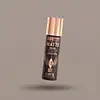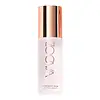What's inside
What's inside
 Key Ingredients
Key Ingredients

No key ingredients
 Benefits
Benefits

 Concerns
Concerns

No concerns
 Ingredients Side-by-side
Ingredients Side-by-side

Water
Skin ConditioningPolysilicone-11
Amp-Acrylates/Allyl Methacrylate Copolymer
Pvp
Emulsion StabilisingGlycerin
HumectantAcrylates Copolymer
Pentylene Glycol
Skin ConditioningBackhousia Citriodora Leaf Extract
AstringentCaprylic/Capric Triglyceride
MaskingAloe Barbadensis Extract
Skin ConditioningPistacia Lentiscus Gum
MaskingSilica
AbrasivePolysorbate 20
EmulsifyingLaureth-12
EmulsifyingParfum
MaskingEthylhexylglycerin
Skin ConditioningHydrogenated Lecithin
EmulsifyingPhenoxyethanol
PreservativePhenethyl Alcohol
MaskingHexamethylindanopyran
MaskingWater, Polysilicone-11, Amp-Acrylates/Allyl Methacrylate Copolymer, Pvp, Glycerin, Acrylates Copolymer, Pentylene Glycol, Backhousia Citriodora Leaf Extract, Caprylic/Capric Triglyceride, Aloe Barbadensis Extract, Pistacia Lentiscus Gum, Silica, Polysorbate 20, Laureth-12, Parfum, Ethylhexylglycerin, Hydrogenated Lecithin, Phenoxyethanol, Phenethyl Alcohol, Hexamethylindanopyran
Water
Skin ConditioningAmp-Acrylates/Allyl Methacrylate Copolymer
Pvp
Emulsion StabilisingPhenoxyethanol
PreservativePentylene Glycol
Skin ConditioningPropanediol
SolventEthylhexylglycerin
Skin ConditioningAloe Barbadensis Leaf Juice Powder
Skin ConditioningPotassium Sorbate
PreservativeCitric Acid
BufferingGlycerin
HumectantCaprylic/Capric Triglyceride
MaskingCamellia Oleifera Leaf Extract
AstringentPistacia Lentiscus Gum
MaskingHydrogenated Lecithin
EmulsifyingLeuconostoc/Radish Root Ferment Filtrate
AntimicrobialPhenethyl Alcohol
MaskingWater, Amp-Acrylates/Allyl Methacrylate Copolymer, Pvp, Phenoxyethanol, Pentylene Glycol, Propanediol, Ethylhexylglycerin, Aloe Barbadensis Leaf Juice Powder, Potassium Sorbate, Citric Acid, Glycerin, Caprylic/Capric Triglyceride, Camellia Oleifera Leaf Extract, Pistacia Lentiscus Gum, Hydrogenated Lecithin, Leuconostoc/Radish Root Ferment Filtrate, Phenethyl Alcohol
Ingredients Explained
These ingredients are found in both products.
Ingredients higher up in an ingredient list are typically present in a larger amount.
We don't have a description for Amp-Acrylates/Allyl Methacrylate Copolymer yet.
This ingredient is an emollient, solvent, and texture enhancer. It is considered a skin-softener by helping the skin prevent moisture loss.
It helps thicken a product's formula and makes it easier to spread by dissolving clumping compounds.
Caprylic Triglyceride is made by combining glycerin with coconut oil, forming a clear liquid.
While there is an assumption Caprylic Triglyceride can clog pores due to it being derived from coconut oil, there is no research supporting this.
Learn more about Caprylic/Capric TriglycerideEthylhexylglycerin (we can't pronounce this either) is commonly used as a preservative and skin softener. It is derived from glyceryl.
You might see Ethylhexylglycerin often paired with other preservatives such as phenoxyethanol. Ethylhexylglycerin has been found to increase the effectiveness of these other preservatives.
Glycerin is already naturally found in your skin. It helps moisturize and protect your skin.
A study from 2016 found glycerin to be more effective as a humectant than AHAs and hyaluronic acid.
As a humectant, it helps the skin stay hydrated by pulling moisture to your skin. The low molecular weight of glycerin allows it to pull moisture into the deeper layers of your skin.
Hydrated skin improves your skin barrier; Your skin barrier helps protect against irritants and bacteria.
Glycerin has also been found to have antimicrobial and antiviral properties. Due to these properties, glycerin is often used in wound and burn treatments.
In cosmetics, glycerin is usually derived from plants such as soybean or palm. However, it can also be sourced from animals, such as tallow or animal fat.
This ingredient is organic, colorless, odorless, and non-toxic.
Glycerin is the name for this ingredient in American English. British English uses Glycerol/Glycerine.
Learn more about GlycerinHydrogenated Lecithin is created from the hydrogenation of lecithin (a group of phospholipids). Hydrogenation is a chemical reaction between hydrogen and another element.
This ingredient is an emollient and emulsifier. As an emollient, it helps soften skin by trapping moisture within. As an emulsifier, it prevents oil and water ingredients from separating.
Pentylene glycol is typically used within a product to thicken it. It also adds a smooth, soft, and moisturizing feel to the product. It is naturally found in plants such as sugar beets.
The hydrophilic trait of Pentylene Glycol makes it a humectant. As a humectant, Pentylene Glycol helps draw moisture from the air to your skin. This can help keep your skin hydrated.
This property also makes Pentylene Glycol a great texture enhancer. It can also help thicken or stabilize a product.
Pentylene Glycol also acts as a mild preservative and helps to keep a product microbe-free.
Some people may experience mild eye and skin irritation from Pentylene Glycol. We always recommend speaking with a professional about using this ingredient in your routine.
Pentylene Glycol has a low molecular weight and is part of the 1,2-glycol family.
Learn more about Pentylene GlycolPhenethyl Alcohol is a colorless and aromatic alohol. It is naturally occuring in essential oils.
The scent of this ingredient is floral and often compared to rose.
Like other alcohols, this ingredient helps prevent the growth of bacteria. However, its main purpose is to impact a fragrance.
Learn more about Phenethyl AlcoholPhenoxyethanol is a preservative that has germicide, antimicrobial, and aromatic properties. Studies show that phenoxyethanol can prevent microbial growth. By itself, it has a scent that is similar to that of a rose.
It's often used in formulations along with Caprylyl Glycol to preserve the shelf life of products.
This ingredient is also known as mustic gum and from a tree native to the Mediterranean Basin.
It has fragrance and masking properties.
Fun fact: This ingredient has been used as chewing gum for at least 2,400 years.
Learn more about Pistacia Lentiscus GumPvp is a water-soluble synthetic polymer and common hairstyling ingredient. It is a film-forming ingredient and used to "hold" specific shapes of hair.
Pvp is less effective in high-humidity. It tends to draw moisture, but this moisture dismantles the structure and "hold".
Water. It's the most common cosmetic ingredient of all. You'll usually see it at the top of ingredient lists, meaning that it makes up the largest part of the product.
So why is it so popular? Water most often acts as a solvent - this means that it helps dissolve other ingredients into the formulation.
You'll also recognize water as that liquid we all need to stay alive. If you see this, drink a glass of water. Stay hydrated!
Learn more about Water